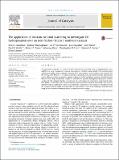Files in this item
The application of inelastic neutron scattering to investigate CO hydrogenation over an iron Fischer–Tropsch synthesis catalyst
Item metadata
| dc.contributor.author | Hamilton, Neil G. | |
| dc.contributor.author | Warringham, Robbie | |
| dc.contributor.author | Silverwood, Ian P. | |
| dc.contributor.author | Kapitán, Josef | |
| dc.contributor.author | Hecht, Lutz | |
| dc.contributor.author | Webb, Paul B. | |
| dc.contributor.author | Tooze, Robert P. | |
| dc.contributor.author | Zhou, Wuzong | |
| dc.contributor.author | Frost, Christopher D. | |
| dc.contributor.author | Parker, Stewart F. | |
| dc.contributor.author | Lennon, David | |
| dc.date.accessioned | 2014-05-13T14:01:02Z | |
| dc.date.available | 2014-05-13T14:01:02Z | |
| dc.date.issued | 2014-04 | |
| dc.identifier | 118163973 | |
| dc.identifier | a61c3a7c-63f0-48bd-ad9c-8d682fd932ba | |
| dc.identifier | 84896129306 | |
| dc.identifier | 000335111300022 | |
| dc.identifier.citation | Hamilton , N G , Warringham , R , Silverwood , I P , Kapitán , J , Hecht , L , Webb , P B , Tooze , R P , Zhou , W , Frost , C D , Parker , S F & Lennon , D 2014 , ' The application of inelastic neutron scattering to investigate CO hydrogenation over an iron Fischer–Tropsch synthesis catalyst ' , Journal of Catalysis , vol. 312 , pp. 221-231 . https://doi.org/10.1016/j.jcat.2014.02.004 | en |
| dc.identifier.issn | 0021-9517 | |
| dc.identifier.other | RIS: urn:812FE781756F3C9DF958E69A2078E708 | |
| dc.identifier.other | ORCID: /0000-0001-9752-7076/work/58055096 | |
| dc.identifier.other | ORCID: /0000-0003-2532-344X/work/67167805 | |
| dc.identifier.uri | https://hdl.handle.net/10023/4776 | |
| dc.description | Funding: Sasol Technology UK Ltd., STFC (CCLRC) and the University of Glasgow- provision of studentships (NGH and RW). The development of INS sample cells and associated sample handling capability was supported by funding from the EPSRC (Grant Number EP/E028861/1). | en |
| dc.description.abstract | An iron Fischer–Tropsch (F–T) catalyst has been prepared and evaluated using CO hydrogenation at 623 and 723 K as a test reaction. Micro-reactor measurements establish reaction profiles. The reaction is then scaled up to enable inelastic neutron scattering (INS) measurements of the catalyst to be acquired. The INS spectra (200–4000 cm-1) are characterised by a combination of hydrocarbon moieties and hydroxyl groups. Whereas the low temperature sample is characterised by an aliphatic overlayer, the hydrocarbon features of the high temperature sample are attributed to partially hydrogenated polycyclic aromatic compounds. The catalyst is further characterised by a combination of temperature-programmed oxidation, powder X-ray diffraction, Raman scattering and transmission electron microscopy. This series of measurements is combined to propose a model for the composition of the catalyst as it progresses from the precursor state to steady-state operation. The work features some of the challenges associated with using INS to characterise heterogeneously catalysed reactions systems. | |
| dc.format.extent | 11 | |
| dc.format.extent | 1535302 | |
| dc.language.iso | eng | |
| dc.relation.ispartof | Journal of Catalysis | en |
| dc.subject | Fischer–Tropsch synthesis | en |
| dc.subject | Iron catalyst | en |
| dc.subject | CO hydrogenation | en |
| dc.subject | Inelastic neutron scattering | en |
| dc.subject | QD Chemistry | en |
| dc.subject.lcc | QD | en |
| dc.title | The application of inelastic neutron scattering to investigate CO hydrogenation over an iron Fischer–Tropsch synthesis catalyst | en |
| dc.type | Journal article | en |
| dc.contributor.institution | University of St Andrews. School of Chemistry | en |
| dc.contributor.institution | University of St Andrews. EaSTCHEM | en |
| dc.identifier.doi | https://doi.org/10.1016/j.jcat.2014.02.004 | |
| dc.description.status | Peer reviewed | en |
| dc.identifier.url | http://www.sciencedirect.com/science/article/pii/S0021951714000438 | en |
This item appears in the following Collection(s)
Items in the St Andrews Research Repository are protected by copyright, with all rights reserved, unless otherwise indicated.

